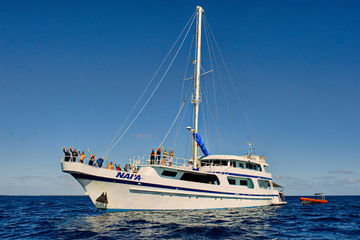Namena Marine Reserve Snorkeling
Namena Marine Reserve Snorkeling
Snorkelling in Namena Marine Reserve means seeing an incredible diverse group marine species of all shapes and sizes in a completely protected marine area. The Namena Marine Reserve stretches between the two Namena islands; Viti Levu and Vanua Levu. The protected area is 70km squared and it has been named a “no take” zone since 1997. Namena Marine Reserve snorkelling allows you to spot some of the smallest but yet most impressive species including nudibranchs, seahorses, shrimps and even the adorable pygmy seahorses, all which inhabit the remote and colourful reefs. With the visibility being great in general there is always much to see! Some snorkel spots might be slightly more challenging, but with each challenge comes a bonus, such as some have strong currents but this is made up for with fantastic visibility, for example.
1 Snorkeling Cruise in Namena Marine ReserveExplore all liveaboards
MARINE LIFE IN NAMENA MARINE RESERVE
The marine life in Namena marine reserve is incredibly diverse and will provide for some exciting snorkel trips. At this point in time they have recorded over 1200 species of fish and invertebrates, over 400 species of corals, four out of seven sea turtle species and 12 species of whales which migrate past here and even calf here. Besides the flourishing reefs which you will come across, some of the larger species you might run into include white tip reef sharks, grey tip reef sharks, hammerhead sharks, large manta rays, large schools of trevally, surgeon fish and fusiliers. Hawksbill turtles come to nest on both the islands so there will be a large chance you will see the gentle creatures gliding through the waters underneath you. This is also the only known Humpback whale calving spot in Fiji; which is truly unique.
BEST SNORKEL SPOTS
NORTH SAVE-A-TACK: Concentrated schools of big fish and beautiful soft coral bommies (seamounts), giant schools of bigeye trevally, scad, and barracuda are watched over by several grey reef shark and white tip reef sharks; you will see from the top how this snorkel and dive spot includes a sheer drop past a sea wall but then also a plateau which inhabits all this variety of species. There can sometimes be strong currents, but this ensures the visibility is fantastic at this snorkel site.
MAGIC MOUND: On the opposite side of the north save-a-track passage there area group of these ‘bommies’ or more commonly known seamounts, including magic mound. You can snorkel over top these mounds and they are all flourishing in their own ways, and extremely colourful, definitely a unique site to see.
WHEN TO GO
Fiji is an all year round snorkelling location, but for the absolute best visibility the months July to December are the best and this is due to the water temperatures being cooler during these months; it ranges from 22 C to 25 C. During the summer months, which run from November to April, the waters are at their warmest, which in one sense is of course really pleasant, but it also attracts a lot of plankton which has an effect on the visibility; visibility which is especially important for snorkelling. The waters are around 28 C to 30 C. The major benefits of visiting during the summer months is that you will see larger species of whales and manta rays who come to feed on the plankton.
HOW TO GET TO NAMENA MARINE RESERVE?
The main international airport of Fiji is Nadi International airport, from here flights arrive from multiple international destinations including a few Australian cities, cities in New Zealand, Singapore and Hawaii. From Nadi International airport you can fly domestically to Nausori airport which is located on the eastern side of Viti Levu, 30 minutes from Suva which is the main port from which you can board your Fiji liveaboard to get to Namena Marine Reserve.







